Relationship between the Composition and Elastic Modulus of TiZrTa Alloys for Implant Materials
Abstract
:1. Introduction
2. Materials and Methods
3. Results and Discussion
4. Conclusions
- The TiZrTa alloys with a composition of 20.51 at.% Zr and 8.96 at.% Ta had the lowest modulus value of 61.3 GPa. The alloy with the other two compositions, C1 (20.85 at.% Zr and 10.55 at.% Ta) and C2 (19.72 at.% Zr and 13.61 at.% Ta) also had a modulus below 70 GPa.
- The TiZrTa alloy with the average valence electron per atom value of 4.09 had the lowest elastic modulus. The alloys with an e/a ratio range of 4.09 to 4.15 had a low modulus.
- The TiZrTa alloys expecting a low elastic modulus should have compositions as follows. The upper content limits of Zr and Ta could be expressed as Ta = 2.63 × 10−2 Zr + 15. Correspondingly, the lower limits obey the equation of Ta = 8.42 × 10−2 Zr + 15.
Author Contributions
Funding
Institutional Review Board Statement
Informed Consent Statement
Data Availability Statement
Conflicts of Interest
References
- Hothan, A.; Lewerenz, K.; Weiss, C.; Hoffmann, N.; Morlock, M.; Huber, G. Vibration transfer in the ball-stem contact interface of artificial hips. Med. Eng. Phys. 2013, 35, 1513–1517. [Google Scholar] [CrossRef] [PubMed]
- McCracken, M. Dental Implant Materials: Commercially Pure Titanium and Titanium Alloys. J. Prosthodont. 1999, 8, 40–43. [Google Scholar] [CrossRef] [PubMed]
- Imam, M.A.; Fraker, A.C. Titanium alloys as implant materials. In Medical Applications of Titanium and Its Alloys: The Material and Biological Issues; ASTM International: West Conshohocken, PA, USA, 1996; pp. 3–16. [Google Scholar]
- Kuroda, D.; Niinomi, M.; Morinaga, M.; Kato, Y.; Yashiro, T. Design and mechanical properties of new β type titanium alloys for implant materials. Mater. Sci. Eng. A 1998, 243, 244–249. [Google Scholar] [CrossRef]
- Niinomi, M. Mechanical biocompatibilities of titanium alloys for biomedical applications. J. Mech. Behav. Biomed. Mater. 2008, 1, 30–42. [Google Scholar] [CrossRef] [PubMed]
- Niinomi, M.; Nakai, M.; Hieda, J. Development of new metallic alloys for biomedical applications. Acta Biomater. 2012, 8, 3888–3903. [Google Scholar] [CrossRef]
- Niinomi, M.; Nakai, M. Titanium-Based Biomaterials for Preventing Stress Shielding between Implant Devices and Bone. Int. J. Biomater. 2011, 2011, 836587. [Google Scholar] [CrossRef]
- Steinemann, S.G. Corrosion of surgical implants-in vivo and in vitro tests. Eval. Biomater. 1980, 1, 1–34. [Google Scholar]
- Kawara, H. Cytotoxicity of implantable metals and alloy. Bull. Jpn. Inst. Met. 1992, 31, 1033–1039. [Google Scholar] [CrossRef]
- Yu, G.; Li, Z.; Li, S.; Zhang, Q.; Hua, Y.; Liu, H.; Zhao, X.; Dhaidhai, D.T.; Li, W.; Wang, X. The select of internal architecture for porous Ti alloy scaffold: A compromise between mechanical properties and permeability. Mater. Des. 2020, 192, 108754. [Google Scholar] [CrossRef]
- Liang, S.X.; Feng, X.J.; Yin, L.X.; Liu, X.Y.; Ma, M.Z.; Liu, R.P. Development of a new beta Ti alloy with low modulus and favorable plasticity for implant material. Mater. Sci. Eng. C Mater. Biol. Appl. 2016, 61, 338–343. [Google Scholar] [CrossRef]
- Hafeez, N.; Liu, J.; Wang, L.; Wei, D.; Tang, Y.; Lu, W.; Zhang, L.-C. Superelastic response of low-modulus porous beta-type Ti-35Nb-2Ta-3Zr alloy fabricated by laser powder bed fusion. Addit. Manuf. 2020, 34, 101264. [Google Scholar] [CrossRef]
- Li, Y.-H.; Shang, X.-Y. Recent progress in porous TiNb-based alloys for biomedical implant applications. Mater. Sci. Technol. 2020, 36, 385–392. [Google Scholar] [CrossRef]
- Qi, P.; Li, B.; Wang, T.; Zhou, L.; Nie, Z. Microstructure and properties of a novel ternary Ti–6Zr–xFe alloy for biomedical applications. J. Alloys Compd. 2021, 854, 157119. [Google Scholar] [CrossRef]
- Hu, S.; Li, T.; Su, Z.; Liu, D. Research on suitable strength, elastic modulus and abrasion resistance of Ti–Zr–Nb medium entropy alloys (MEAs) for implant adaptation. Intermetallics 2022, 140, 107401. [Google Scholar] [CrossRef]
- Shi, Y.D.; Wang, L.N.; Liang, S.X.; Zhou, Q.; Zheng, B. A high Zr-containing Ti-based alloy with ultralow Young′s modulus and ultrahigh strength and elastic admissible strain. Mater. Sci. Eng. A 2016, 674, 696–700. [Google Scholar] [CrossRef]
- Kuroda, P.A.B.; de Freitas Quadros, F.; Sousa, K.d.S.J.; Donato, T.A.G.; de Araújo, R.O.; Grandini, C.R. Preparation, structural, microstructural, mechanical and cytotoxic characterization of as-cast Ti-25Ta-Zr alloys. J. Mater. Sci. Mater. M 2020, 31, 19. [Google Scholar] [CrossRef]
- Yan, L.; Yuan, Y.; Ouyang, L.; Li, H.; Mirzasadeghi, A.; Li, L. Improved mechanical properties of the new Ti-15Ta-xZr alloys fabricated by selective laser melting for biomedical application. J. Alloys Compd. 2016, 688, 156–162. [Google Scholar] [CrossRef]
- Zheng, X.H.; Ning, R.; Tan, C.L.; Huang, S.; Zhang, Z.G.; Cai, W. The effects of indium addition on mechanical properties and shape memory behavior of Ti-Ta-Zr high temperature alloys. Mater. Chem. Phys. 2020, 249, 123189. [Google Scholar] [CrossRef]
- Popov, A.A.; Illarionov, A.G.; Grib, S.V.; Elkina, O.A.; Ivasishin, O.M.; Markovskii, P.E.; Skiba, I.A. Effect of heat treatment and plastic deformation on the structure and elastic modulus of a biocompatible alloy based on zirconium and titanium. Phys. Met. Metallogr. 2012, 113, 382–390. [Google Scholar] [CrossRef]
- Liang, S. Review of the Design of Titanium Alloys with Low Elastic Modulus as Implant Materials. Adv. Eng. Mater. 2020, 22, 2000555. [Google Scholar] [CrossRef]
- Chen, Z. A Comprehensive Study of Diffusion and Modulus of Binary Systems within the Ti-Mo-Nb-Ta-Zr System. Ph.D. Thesis, The Ohio State University, Columbus, OH, USA, 2019. [Google Scholar]
- Ling, J.; Huang, D.; Bai, K.; Li, W.; Yu, Z.; Chen, W. High-throughput development and applications of the compositional mechanical property map of the β titanium alloys. J. Mater. Sci. Technol. 2021, 71, 201–210. [Google Scholar] [CrossRef]
- Wang, B.; Ruan, W.; Liu, J.; Zhang, T.; Yang, H.; Ruan, J. Microstructure, mechanical properties, and preliminary biocompatibility evaluation of binary Ti-Zr alloys for dental application. J. Biomater. Appl. 2019, 33, 766–775. [Google Scholar] [CrossRef] [PubMed]
- Liang, S.; Zhou, Y.; Yin, L. Strengthening/Weakening Action of Zr on Stabilizers of Ti Alloys and Its Effect on Phase Transition. J. Mater. Eng. Perform. 2021, 30, 876–884. [Google Scholar] [CrossRef]
- Aniskin, M.V.; Ignatova, O.N.; Kaganova, I.I.; Kalmanov, A.V.; Koshatova, E.V.; Lebedev, A.I.; Losev, V.V.; Podurets, A.M.; Polyakov, L.V.; Tkachenko, M.I.; et al. Mechanical properties of tantalum with different types of microstructure under high-rate deformation. Phys. Mesomech. 2011, 14, 79–84. [Google Scholar] [CrossRef]
- Oliver, W.; Pharr, G. An Improved Technique for Determining Hardness and Elastic Modulus Using Load and Displacement Sensing Indentation Experiments. J. Mater. Res. 1992, 7, 1564–1583. [Google Scholar] [CrossRef]
- Oliver, W.; Pharr, G.M. Measurement of hardness and elastic modulus by instrumented indentation. J. Mater. Res. 2004, 19, 3–20. [Google Scholar] [CrossRef]
- Zareidoost, A.; Yousefpour, M. A study on the mechanical properties and corrosion behavior of the new as-cast TZNT alloys for biomedical applications. Mater. Sci. Eng. C 2020, 110, 110725. [Google Scholar] [CrossRef] [PubMed]
- Zhao, Y.; Singaravelu, A.S.S.; Ma, X.; Liu, X.; Chawla, N. Mechanical properties of Al3BC by nanoindentation and micropillar compression. Mater. Lett. 2020, 264, 127361. [Google Scholar] [CrossRef]
- Kim, S.-P.; Kaseem, M.; Choe, H.-C. Plasma electrolytic oxidation of Ti-25Nb-xTa alloys in solution containing Ca and P ions. Surf. Coat. Technol. 2020, 395, 125916. [Google Scholar] [CrossRef]
- Liu, Y.; Zhang, L.; Du, Y.; Wang, J.; Liang, D. Study of atomic mobilities and diffusion characteristics in bcc Ti–Ta and Ta–W alloys. Calphad 2010, 34, 310–316. [Google Scholar] [CrossRef]
- Ansel, D.; Thibon, I.; Boliveau, M.; Debuigne, J. Interdiffusion in the body cubic centeredβ-phase of Ta–Ti alloys. Acta Mater. 1998, 46, 423–430. [Google Scholar] [CrossRef]
- Martienssen, W. Springer Handbook of Condensed Matter and Materials Data, 1st ed.; Martienssen, W., Warlimont, H., Eds.; Springer: Berlin/Heidelberg, Germany, 2005. [Google Scholar]
- Correa, D.R.N.; Vicente, F.B.; Donato, T.A.G.; Arana-Chavez, V.E.; Buzalaf, M.A.R.; Grandini, C.R. The effect of the solute on the structure, selected mechanical properties, and biocompatibility of Ti–Zr system alloys for dental applications. Mater. Sci. Eng. C. 2014, 34, 354–359. [Google Scholar] [CrossRef] [PubMed]
- Hume-Rothery, W.; Mabbott, G.W.; Channel Evans, K.M.; Carpenter, H.C.H. The freezing points, melting points, and solid solubility limits of the alloys of sliver and copper with the elements of the b sub-groups. Philos. Trans. R. Soc. Lond. Ser. A Contain. Pap. A Math. Phys. Character 1934, 233, 1–97. [Google Scholar]
- Laheurte, P.; Prima, F.; Eberhardt, A.; Gloriant, T.; Wary, M.; Patoor, E. Mechanical properties of low modulus β titanium alloys designed from the electronic approach. J. Mech. Behav. Biomed. Mater. 2010, 3, 565–573. [Google Scholar] [CrossRef] [PubMed]
- Moshokoa, N.; Raganya, L.; Obadele, B.; Olubambi, P.; Machaka, R. Effects of Mo content on the microstructural and mechanical properties of as-cast Ti-Mo alloys. IOP Conf. Ser. Mater. Sci. Eng. 2019, 655, 012015. [Google Scholar] [CrossRef]
- Xu, Y.; Gao, J.; Huang, Y.; Rainforth, W.M. A low-cost metastable beta Ti alloy with high elastic admissible strain and enhanced ductility for orthopaedic application. J. Alloys Compd. 2020, 835, 155391. [Google Scholar] [CrossRef]
- You, L.; Song, X. First principles study of low Young’s modulus Ti–Nb–Zr alloy system. Mater. Lett. 2012, 80, 165–167. [Google Scholar] [CrossRef]
- Hao, Y.L.; Li, S.J.; Sun, S.Y.; Zheng, C.Y.; Yang, R. Elastic deformation behaviour of Ti-24Nb-4Zr-7.9Sn for biomedical applications. Acta Biomater. 2007, 3, 277–286. [Google Scholar] [CrossRef]
- Biesiekierski, A.; Ping, D.; Li, Y.; Lin, J.; Munir, K.S.; Yamabe-Mitarai, Y.; Wen, C. Extraordinary high strength Ti-Zr-Ta alloys through nanoscaled, dual-cubic spinodal reinforcement. Acta Biomater. 2017, 53, 549–558. [Google Scholar] [CrossRef] [PubMed]
- Vulcan, A.D.; Răducanu, D.; Cojocaru, V.D.; Cincă, I. The evolution of mechanical characteristics for a thermomechanical processed Ti-Ta-Zr alloy. UPB Sci. Bull. Ser. B Chem. Mater. Sci. 2011, 73, 229–236. [Google Scholar]
- Kuroda, P.A.B.; Quadros, F.d.F.; Afonso, C.R.M.; Grandini, C.R. The Effect of Solution Heat Treatment Temperature on Phase Transformations, Microstructure and Properties of Ti-25Ta-xZr Alloys Used as a Biomaterial. J. Mater. Eng. Perform. 2020, 29, 2410–2417. [Google Scholar] [CrossRef]
- Kuroda, P.A.B.; Pedroso, B.L.T.; Pontes, F.M.L.; Grandini, C.R. Effect of Titanium Addition on the Structure, Microstructure, and Selected Mechanical Properties of As-Cast Zr-25Ta-xTi Alloys. Metals 2021, 11, 1507. [Google Scholar] [CrossRef]
- Wu, R.; Yi, Q.; Lei, S.; Dai, Y.; Lin, J. Design of Ti-Zr-Ta Alloys with Low Elastic Modulus Reinforced by Spinodal Decomposition. Coatings 2022, 12, 756. [Google Scholar] [CrossRef]
- Xue, G.-l.; Yang, H.-l.; Xing, H.-x.; Ye, C.-r.; Liu, J.; Miao, J.-l.; Ruan, J.-m. Effect of Ti on microstructure, mechanical properties and corrosion resistance of Zr-Ta-Ti alloys processed by spark plasma sintering. J. Cent. South Univ. 2020, 27, 2185–2197. [Google Scholar] [CrossRef]
- Biesiekierski, A.; Wang, J.; Abdel-Hady Gepreel, M.; Wen, C. A new look at biomedical Ti-based shape memory alloys. Acta Biomater. 2012, 8, 1661–1669. [Google Scholar] [CrossRef] [PubMed]
- Liang, S.X.; Ma, M.Z.; Jing, R.; Zhang, X.Y.; Liu, R.P. Microstructure and mechanical properties of hot-rolled ZrTiAlV alloys. Mater. Sci. Eng. A 2012, 532, 1–5. [Google Scholar] [CrossRef]
- Jing, R.; Liang, S.X.; Liu, C.Y.; Ma, M.Z.; Zhang, X.Y.; Liu, R.P. Structure and mechanical properties of Ti–6Al–4V alloy after zirconium addition. Mater. Sci. Eng. A 2012, 552, 295–300. [Google Scholar] [CrossRef]
- Jiang, J.; Zhou, C.; Zhao, Y.; He, F.; Wang, X. Development and properties of dental Ti–Zr binary alloys. J. Mech. Behav. Biomed. Mater. 2020, 112, 104048. [Google Scholar] [CrossRef]
- Yu, Q.; Wang, C.; Wang, D.; Min, X. Microstructure and properties of Ti–Zr congruent alloy fabricated by laser additive manufacturing. J. Alloys Compd. 2020, 834, 155087. [Google Scholar] [CrossRef]
- Gouda, M.K.; Salman, S.A.; Ebied, S.; Ashmawy, A.M.; Gepreel, M.A.H.; Chiba, A. Biocompatibility and corrosion resistance of low-cost Ti–14Mn–Zr alloys. J. Mater. Res. 2021, 36, 4883–4893. [Google Scholar] [CrossRef]
- Martins, D.Q.; Osório, W.R.; Souza, M.E.P.; Caram, R.; Garcia, A. Effects of Zr content on microstructure and corrosion resistance of Ti–30Nb–Zr casting alloys for biomedical applications. Electrochim. Acta 2008, 53, 2809–2817. [Google Scholar] [CrossRef]
- Abdel-Hady, M.; Fuwa, H.; Hinoshita, K.; Kimura, H.; Shinzato, Y.; Morinaga, M. Phase stability change with Zr content in β-type Ti–Nb alloys. Scripta Mater. 2007, 57, 1000–1003. [Google Scholar] [CrossRef]
- Marker, C.; Shang, S.-L.; Zhao, J.-C.; Liu, Z.-K. Elastic knowledge base of bcc Ti alloys from first-principles calculations and CALPHAD-based modeling. Comput. Mater. Sci. 2017, 140, 121–139. [Google Scholar] [CrossRef]
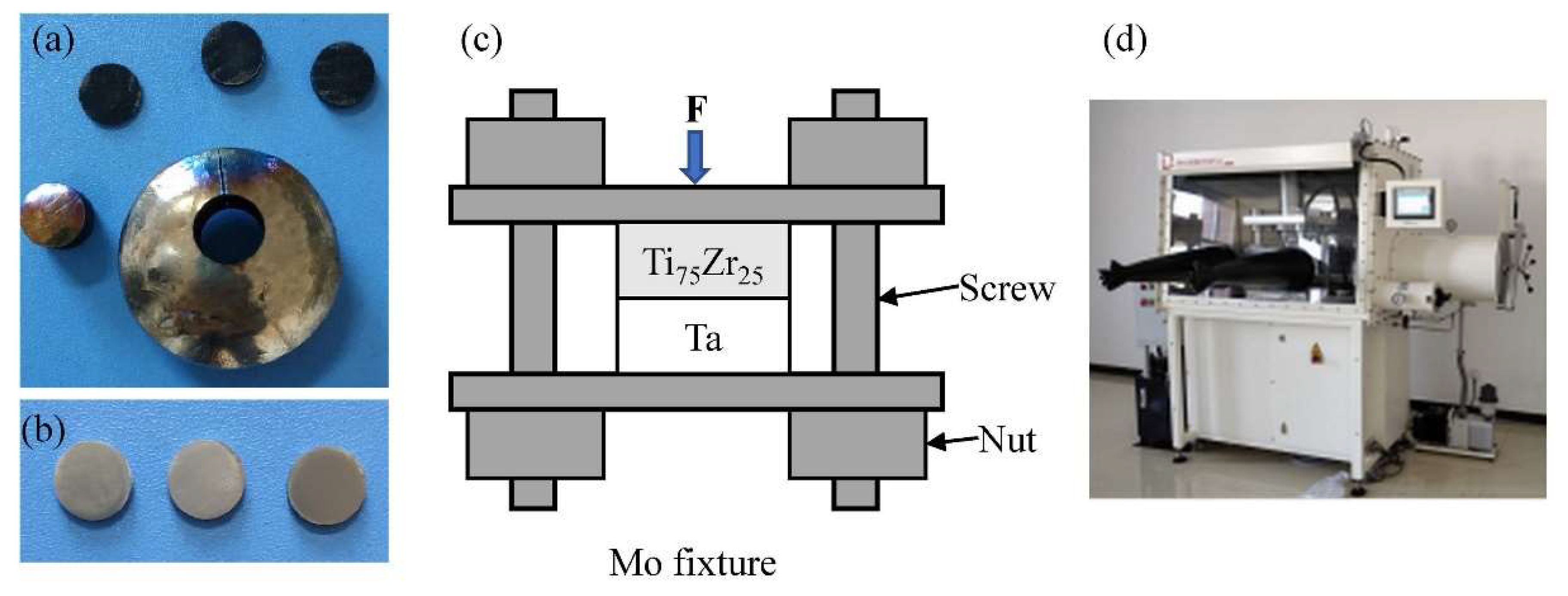


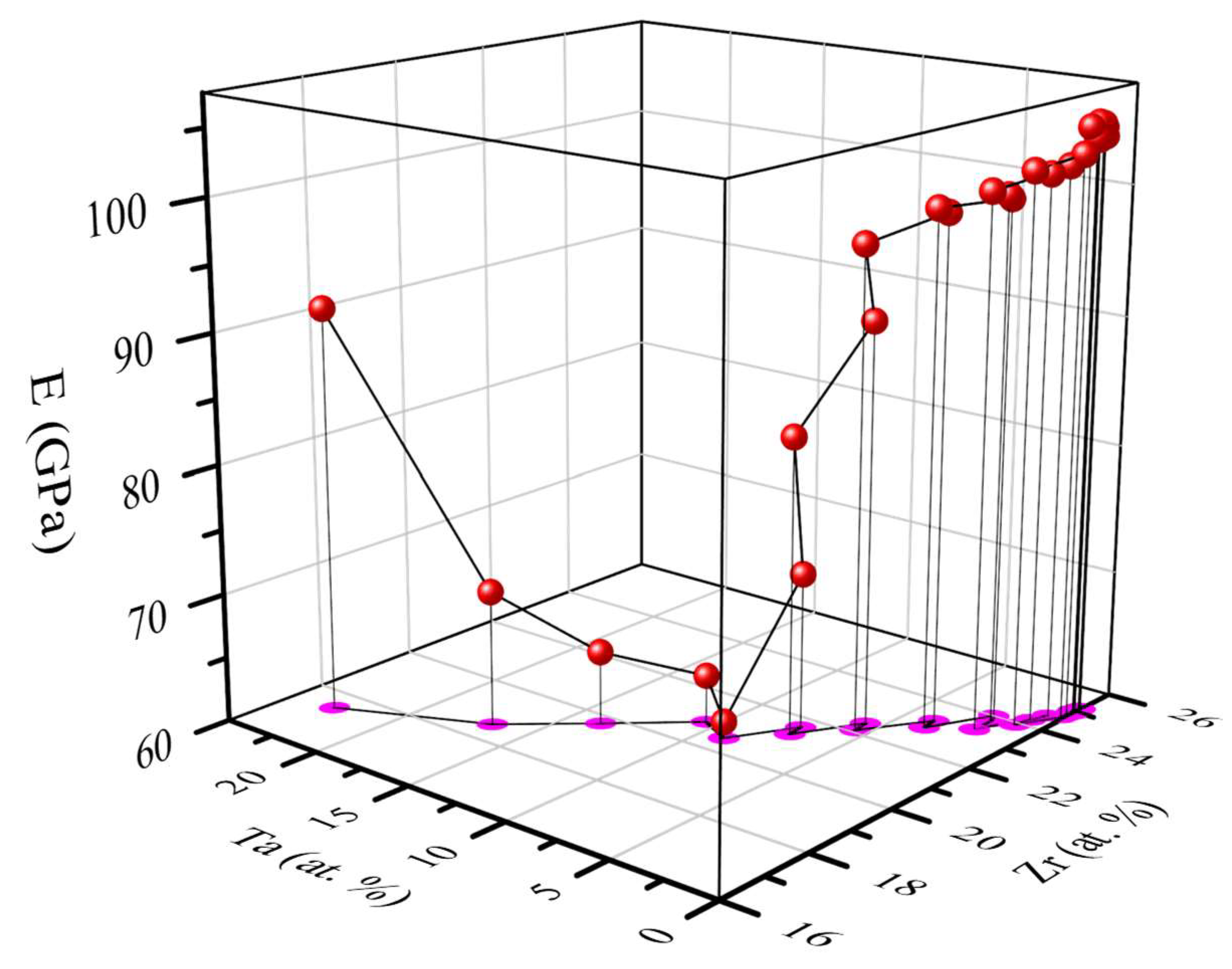
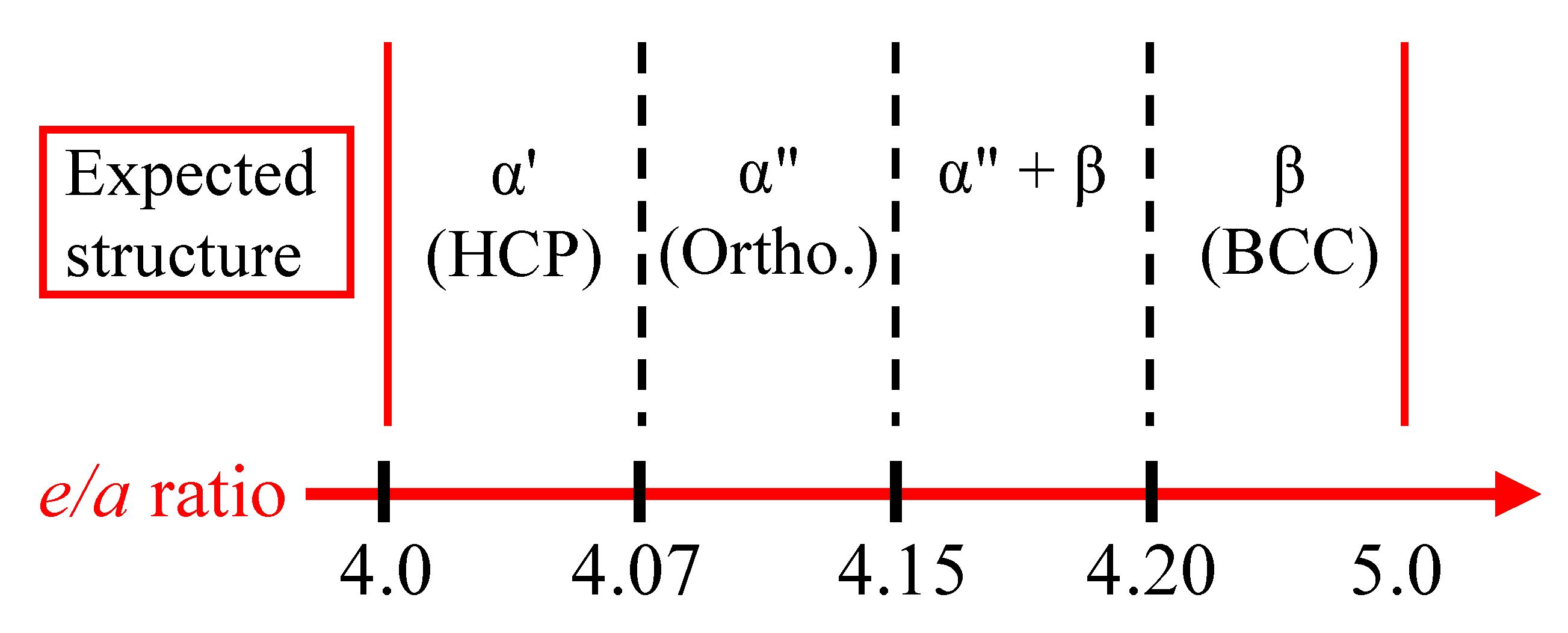
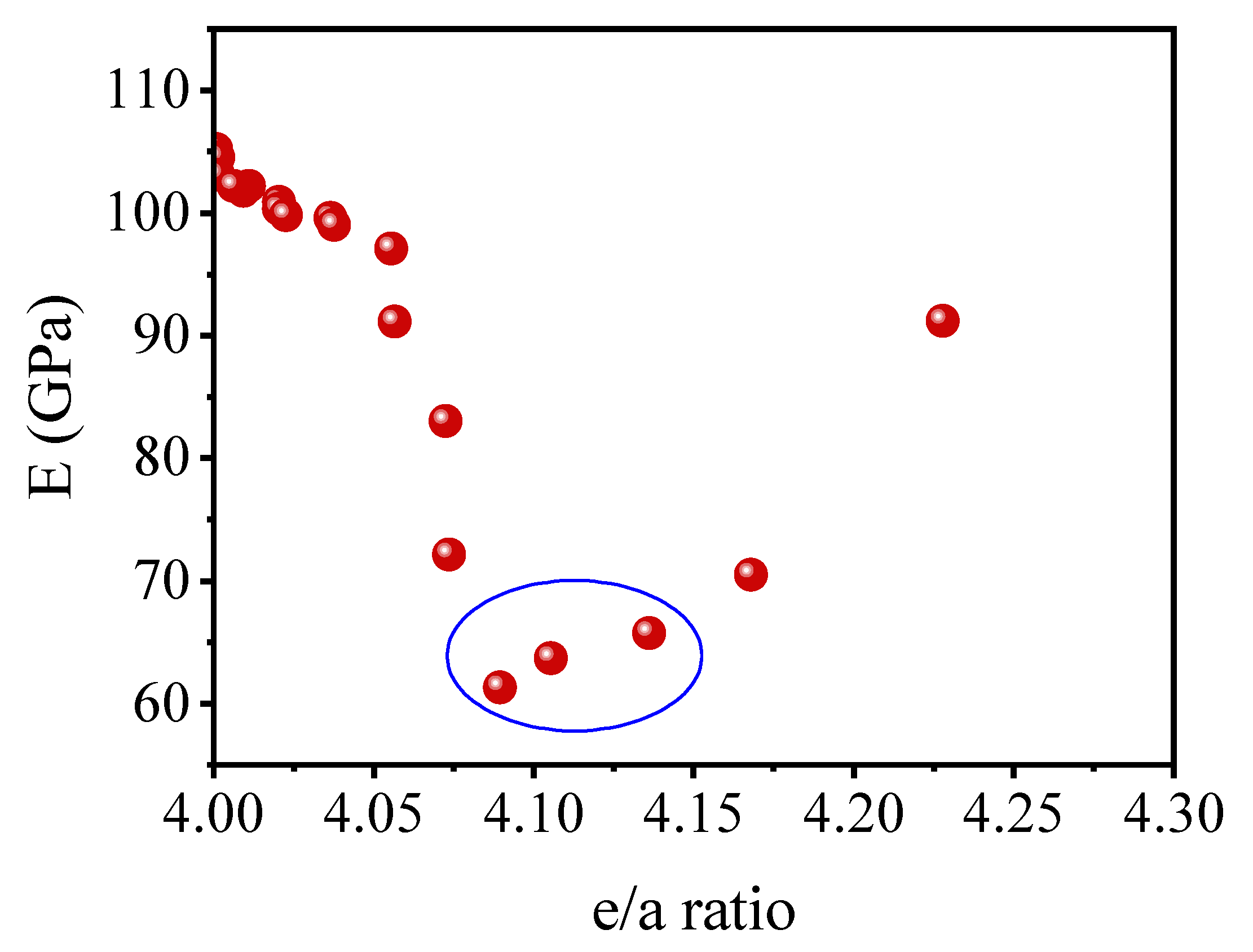


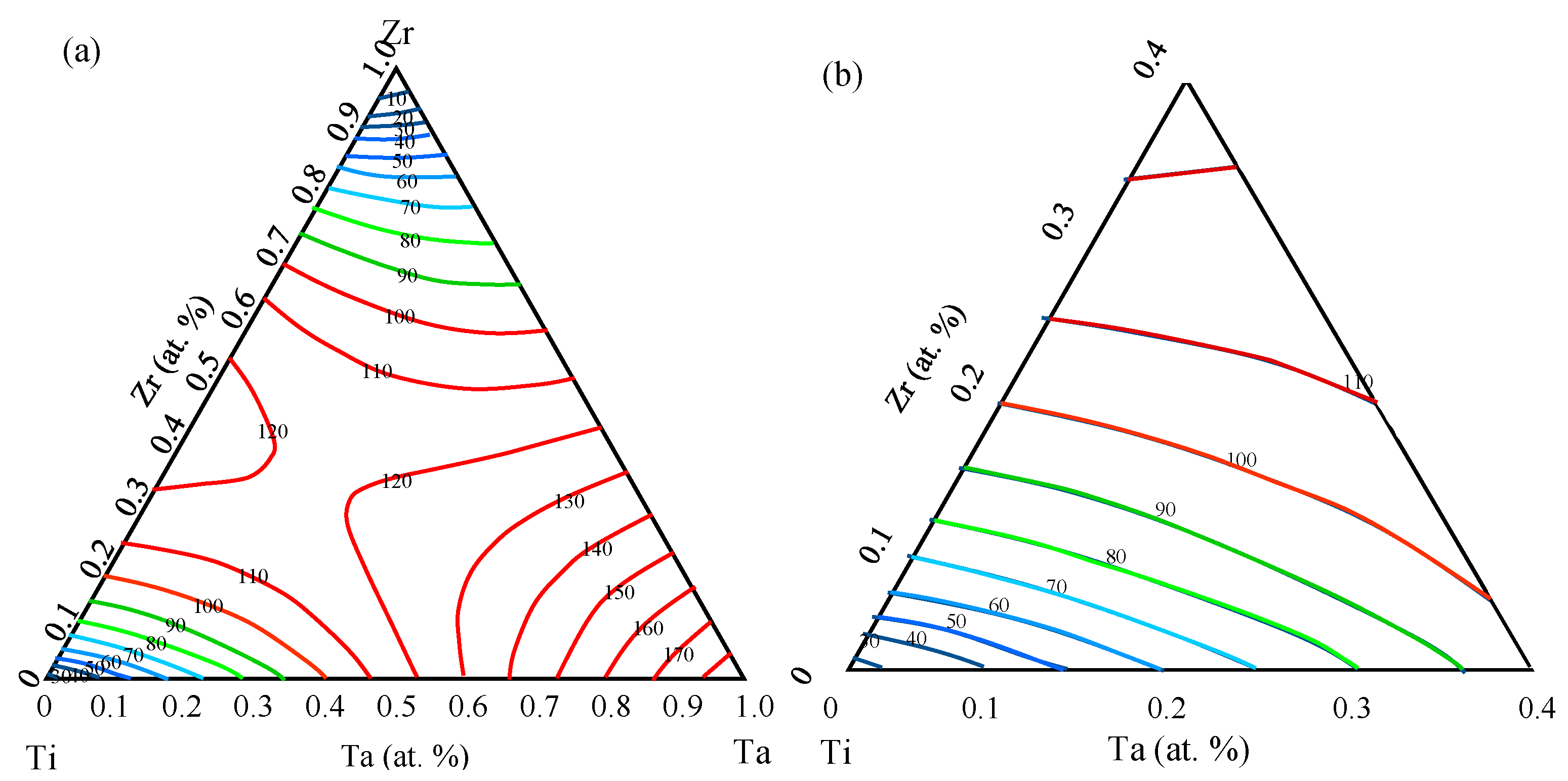
| Impurity Elements (ppm) | Pure Metals | ||
|---|---|---|---|
| Ti | Zr | Ta | |
| Al | - | <5 | - |
| C | <5 | <5 | <1 |
| Cd | - | <1 | - |
| Co | <1 | <5 | - |
| Cr | <1 | <5 | <1 |
| Cu | <1 | <5 | <1 |
| Fe | <1 | <10 | <1 |
| H | - | <5 | <5 |
| Mg | <1 | <5 | - |
| Mn | <1 | <5 | <1 |
| Mo | <1 | - | <1 |
| N | <5 | <5 | <5 |
| Nb | <1 | - | <10 |
| Ni | <1 | - | <1 |
| O | <5 | <5 | <5 |
| Pb | <1 | <1 | - |
| S | <5 | <5 | <5 |
| Si | <1 | <1 | <1 |
| Sn | <1 | - | - |
| Ta | <1 | <1 | Matrix |
| Ti | Matrix | <1 | <1 |
| V | <1 | <5 | - |
| W | <1 | <5 | <5 |
| Zr | <5 | Matrix | <1 |
Publisher’s Note: MDPI stays neutral with regard to jurisdictional claims in published maps and institutional affiliations. |
© 2022 by the authors. Licensee MDPI, Basel, Switzerland. This article is an open access article distributed under the terms and conditions of the Creative Commons Attribution (CC BY) license (https://creativecommons.org/licenses/by/4.0/).
Share and Cite
Zhao, J.; Liu, K.; Ding, M.; Yin, L.; Liang, S. Relationship between the Composition and Elastic Modulus of TiZrTa Alloys for Implant Materials. Metals 2022, 12, 1582. https://doi.org/10.3390/met12101582
Zhao J, Liu K, Ding M, Yin L, Liang S. Relationship between the Composition and Elastic Modulus of TiZrTa Alloys for Implant Materials. Metals. 2022; 12(10):1582. https://doi.org/10.3390/met12101582
Chicago/Turabian StyleZhao, Jinzhu, Kaiyang Liu, Meining Ding, Lixia Yin, and Shunxing Liang. 2022. "Relationship between the Composition and Elastic Modulus of TiZrTa Alloys for Implant Materials" Metals 12, no. 10: 1582. https://doi.org/10.3390/met12101582
APA StyleZhao, J., Liu, K., Ding, M., Yin, L., & Liang, S. (2022). Relationship between the Composition and Elastic Modulus of TiZrTa Alloys for Implant Materials. Metals, 12(10), 1582. https://doi.org/10.3390/met12101582








